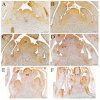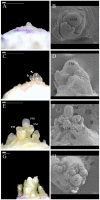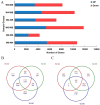Developmental and Molecular Changes Underlying the Vernalization-Induced Transition to Flowering in Aquilegia coerulea (James)
- PMID: 31546687
- PMCID: PMC6826667
- DOI: 10.3390/genes10100734
Developmental and Molecular Changes Underlying the Vernalization-Induced Transition to Flowering in Aquilegia coerulea (James)
Abstract
Reproductive success in plants is dependent on many factors but the precise timing of flowering is certainly among the most crucial. Perennial plants often have a vernalization or over-wintering requirement in order to successfully flower in the spring. The shoot apical meristem undergoes drastic developmental and molecular changes as it transitions into inflorescence meristem (IM) identity, which then gives rise to floral meristems (FMs). In this study, we have examined the developmental and gene expression changes underlying the transition from the vegetative to reproductive phases in the basal eudicot Aquilegia coerulea, which has evolved a vernalization response independently relative to other established model systems. Results from both our histology and scanning electron studies demonstrate that developmental changes in the meristem occur gradually during the third and fourth weeks of vernalization. Based on RNAseq data and cluster analysis, several known flowering time loci, including AqFT and AqFL1, exhibit dramatic changes in expression during the fourth week. Further consideration of candidate gene homologs as well as unexpected loci of interest creates a framework in which we can begin to explore the genetic basis of the flowering time transition in Aquilegia.
Keywords: Aquilegia; FLOWERING LOCUS T; floral meristem; flowering; genetic pathways; inflorescence meristem; vernalization.
Conflict of interest statement
The authors declare no conflict of interest.
Figures






Similar articles
-
The Aquilegia FRUITFULL-like genes play key roles in leaf morphogenesis and inflorescence development.Plant J. 2013 Apr;74(2):197-212. doi: 10.1111/tpj.12113. Epub 2013 Mar 7. Plant J. 2013. PMID: 23294330
-
Environmental and molecular analysis of the floral transition in the lower eudicot Aquilegia formosa.Evodevo. 2011 Feb 17;2:4. doi: 10.1186/2041-9139-2-4. Evodevo. 2011. PMID: 21329499 Free PMC article.
-
Genetic architecture underlying variation in floral meristem termination in Aquilegia.J Exp Bot. 2022 Oct 18;73(18):6241-6254. doi: 10.1093/jxb/erac277. J Exp Bot. 2022. PMID: 35731618 Free PMC article.
-
Reproductive meristem fates in Gerbera.J Exp Bot. 2006;57(13):3445-55. doi: 10.1093/jxb/erl181. Epub 2006 Oct 5. J Exp Bot. 2006. PMID: 17023564 Review.
-
Mechanisms and function of flower and inflorescence reversion.J Exp Bot. 2005 Oct;56(420):2587-99. doi: 10.1093/jxb/eri254. Epub 2005 Aug 30. J Exp Bot. 2005. PMID: 16131510 Review.
Cited by
-
Large-scale analyses of angiosperm Flowering Locus T genes reveal duplication and functional divergence in monocots.Front Plant Sci. 2023 Jan 4;13:1039500. doi: 10.3389/fpls.2022.1039500. eCollection 2022. Front Plant Sci. 2023. PMID: 36684773 Free PMC article.
-
Out of and in East Asia: phylogeny, biogeography and diversification of Thalictroideae (Ranunculaceae) in the Northern Hemisphere.Ann Bot. 2024 Dec 31;134(7):1251-1262. doi: 10.1093/aob/mcae148. Ann Bot. 2024. PMID: 39196797 Free PMC article.
-
Transcriptome and Physio-Biochemical Profiling Reveals Differential Responses of Rice Cultivars at Reproductive-Stage Drought Stress.Int J Mol Sci. 2023 Jan 5;24(2):1002. doi: 10.3390/ijms24021002. Int J Mol Sci. 2023. PMID: 36674519 Free PMC article.
-
Overexpression of four MiTFL1 genes from mango delays the flowering time in transgenic Arabidopsis.BMC Plant Biol. 2021 Sep 7;21(1):407. doi: 10.1186/s12870-021-03199-9. BMC Plant Biol. 2021. PMID: 34493220 Free PMC article.
-
Transcriptome profiling and weighted gene co-expression network analysis of early floral development in Aquilegia coerulea.Sci Rep. 2020 Nov 12;10(1):19637. doi: 10.1038/s41598-020-76750-7. Sci Rep. 2020. PMID: 33184405 Free PMC article.
References
-
- Chouard P. Vernalization and its Relations to Dormancy. Annu. Rev. Plant Physiol. 1960;11:191–238. doi: 10.1146/annurev.pp.11.060160.001203. - DOI
Publication types
MeSH terms
Grants and funding
LinkOut - more resources
Full Text Sources
Miscellaneous

